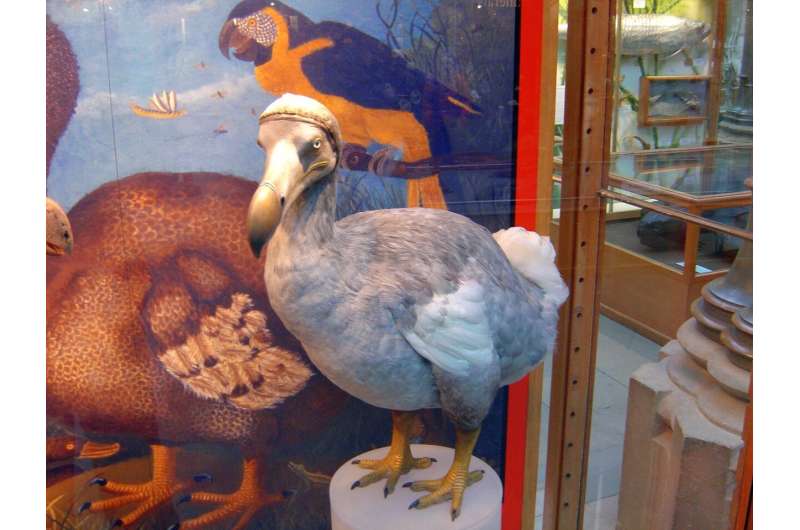This article has been reviewed according to Science X's editorial process and policies. Editors have highlighted the following attributes while ensuring the content's credibility:
fact-checked
reputable news agency
proofread
Scientists are trying to resurrect the dodo centuries after the bird famously went extinct

The list of extinct species that genetic engineering company Colossal wants to bring back to life is growing. The latest addition: the dodo.
Colossal gave life to real-world visions of Jurassic Park in 2021 with its mission of bringing back the wooly mammoth. In August 2022, the company, which has offices in Boston, Dallas and Austin, Texas, said it also planned to de-extinct the Australian thylacine, or Tasmanian tiger.
This new project, announced Tuesday, would bring back a species that's historically highlighted as a case of how humans can contribute to the extinction of an animal species.
When did the dodo become extinct?
The last dodo was killed in 1681, according to Britannica.com. Portuguese sailors discovered the dodo on the island of Mauritius, which is off the east coast of Africa in the Indian Ocean, more than five centuries ago.
The birds, which were larger than turkeys, were killed for food, the site says. Pigs and other animals brought to the island ate dodo eggs.
"The dodo is a prime example of a species that became extinct because we—people—made it impossible for them to survive in their native habitat," said Beth Shapiro, lead paleogeneticist and a member of Colossal's scientific advisory board, in the announcement.
Shapiro, a professor at the University of California-Santa Cruz, led a group that announced in March 2022 it had sequenced the dodo genome. "I am thrilled to collaborate with Colossal and the people of Mauritius on the de-extinction and eventual re-wilding of the dodo," she said. "I particularly look forward to furthering genetic rescue tools focused on birds and avian conservation."
How are scientists trying to bring back extinct species like the wooly mammoth?
Colossal's biotech and genetic engineering teams are combining wooly mammoth and elephant DNA to recreate a next-generation mammoth capable of surviving in the Arctic and helping restore that ecosystem. "These embryos will be implanted into healthy female elephant surrogates with our first calves expected in 5 years," accounting for the 22-month gestation period, Ben Lamm, co-founder and CEO of Colossal, told U.S. TODAY.
A similar process is being used with the Tasmanian tiger's genome and similar mammal DNA to bring back that predator—exterminated in the early 20th century—to the island off the southeast tip of Australia.
Colossal is creating an Avian Genomics Group to bring back the dodo and, eventually, other extinct bird species "through genetic rescue techniques and its de-extinction toolkit," the company said in its announcement. Colossal also announced $150 million in investments, boosting to $225 million its funding since the company's September 2021 debut.
What other benefits might Colossal's research yield?
Gene editing and biotech advances used for de-extinction "will inevitably have utility in the human healthcare field," Lamm said. Gene editing technology such as CRISPR is already being used to correct genetic mutations found in diseases. "We'll be building new tools to enable more complex editing protocols which will advance the state of the art when compared to what is available in the healthcare industry," he said.
(c)2023 USA Today
Distributed by Tribune Content Agency, LLC.




















